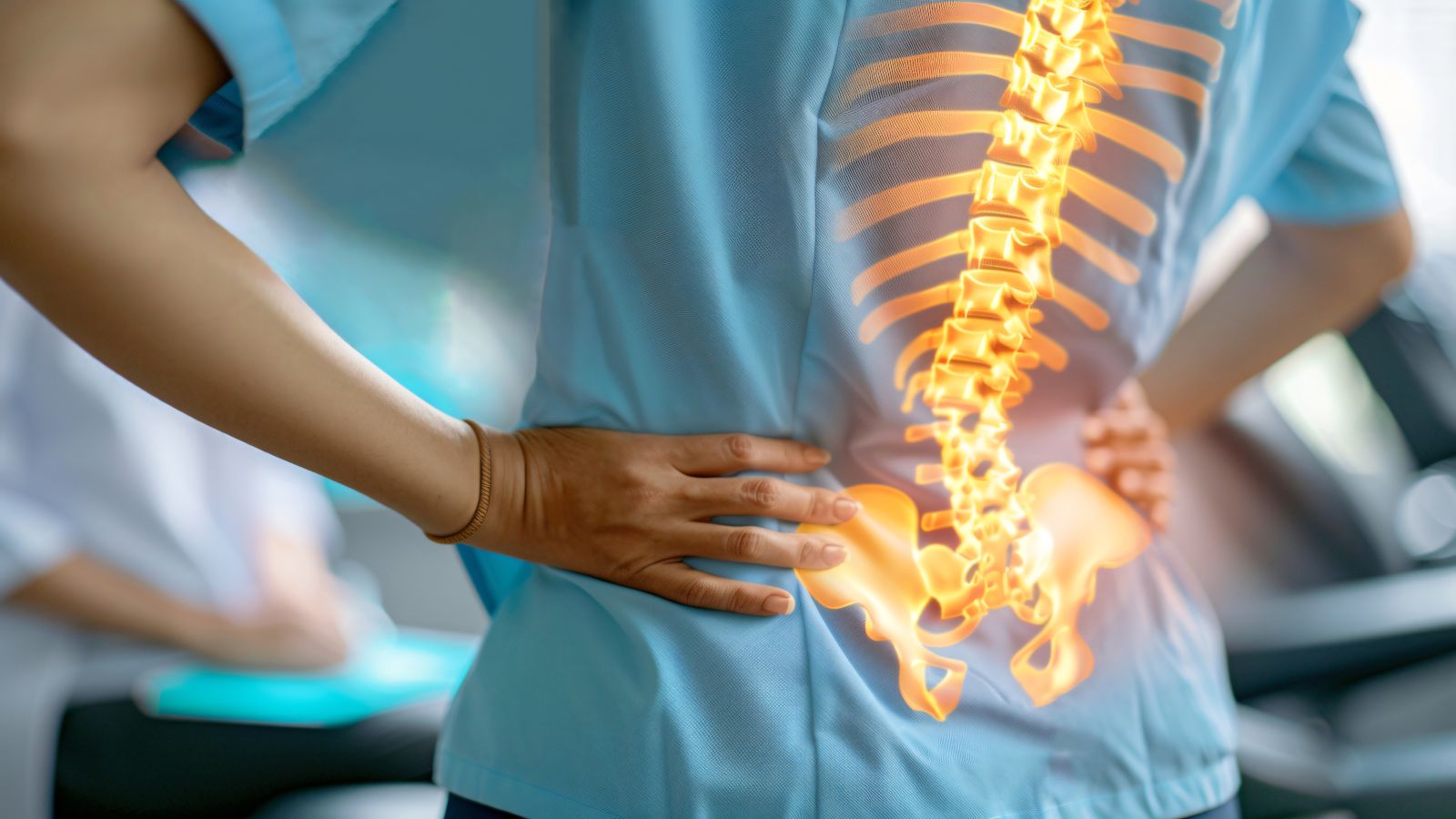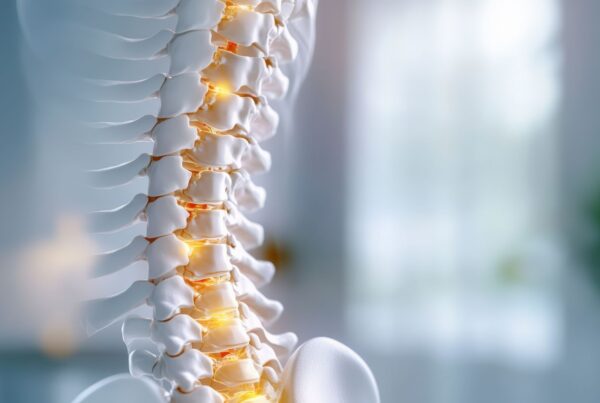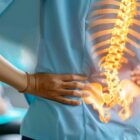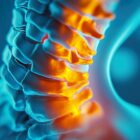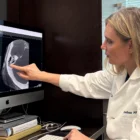You’ve been dealing with nagging hip pain for months. Perhaps you’ve tried hip exercises, changed your sleep habits, or even considered that it might be arthritis. But what if we told you that your hip pain might not be coming from your hip at all? For many people, persistent hip pain is actually a clever disguise worn by spinal stenosis.
This misunderstanding is more common than you might think, and it’s why so many people struggle to find relief. When your spine is the real culprit behind your hip discomfort, treating only the hip is like putting a bandage on the wrong wound.
The Hip-Spine Connection Mystery
Your spine and hips work together as partners in almost everything you do. When you walk, stand, or even sit, your spine and hips share the workload of supporting your body and controlling your movements. This close partnership means that when one area develops problems, the other often feels the effects.
The Nerve Highway
The nerves that control your hip muscles and provide sensation to your hip area travel through your lower spine before reaching their destination. When spinal stenosis narrows the spaces in your spine, these nerves can get compressed or irritated. The result? Pain that you feel in your hip, even though the actual problem is in your back.
Compensation Patterns
When your spine isn’t working properly due to stenosis, your body automatically adjusts how you move. Your hip muscles may work harder to compensate for the spine’s limitations, leading to overuse and pain in the hip area.
Shared Real Estate
Some muscles, like the psoas muscle, connect your spine directly to your hip. When spinal stenosis affects these connecting muscles, you can experience pain that spans both areas.
What Is Hip-Spine Syndrome?
Hip-spine syndrome is the medical term for when both hip and spine problems occur together, creating a complex web of symptoms that can be challenging to untangle. This distinct syndrome occurs when both hip and spinal problems happen together, and because hip and spine disorders have overlapping presentations and symptoms, it often can be challenging for doctors to determine if a patient’s symptoms come from the hip, spine, or both.
The Perfect Storm
Hip-spine syndrome often develops because:
- Both areas are prone to age-related wear and tear
- Problems in one area can lead to problems in the other
- The symptoms can mask each other, making diagnosis difficult
Why It’s Often Missed
Many patients with hip-spine syndrome have seen multiple doctors and tried various treatments without success. This happens because:
- Hip pain naturally leads people to think the problem is in the hip
- Standard hip treatments don’t address spine-related causes
- The connection between the two areas isn’t always obvious
How to Tell If Your Hip Pain Comes from Your Spine
Distinguishing between true hip problems and spine-related hip pain requires some detective work. The location, timing, and behavior of your pain provide important clues.
An important thing to consider is what region of the body you’re referencing when you say you have hip pain. The hip joint itself is in our groin and as such arthritic conditions or labral tears tend to refer pain to the groin region, especially with weight-bearing activities. If the pain is present on the outer portion of the thigh or the upper-lateral buttock area the cause of the discomfort may be coming from a common spinal condition known as spinal stenosis.
True Hip Pain Typically:
- Appears in the groin area
- Feels deep inside the joint
- Worsens with hip movements like getting in/out of cars
- May cause clicking or catching sensations
Spine-Related Hip Pain Often:
- Shows up in the outer thigh or upper buttock
- Feels more surface-level or radiating
- Changes with spine positions (sitting vs. standing)
- Comes with other symptoms like numbness or tingling
It's time to get back
to doing what you love.
Why Spinal Stenosis Causes Hip Pain
Understanding why spinal stenosis creates hip pain helps explain why your symptoms might be confusing and why traditional hip treatments haven’t worked.
Nerve Compression Creates Confusion
When the narrowed spaces in the spine put pressure on your spinal cord and the nerves that travel through the spine, these nerves, being compressed, become dysfunctional and cause symptoms such as pain, weakness, or numbness radiating in the upper buttock region or down the legs in various patterns.
The Referral Pattern
Your nervous system sometimes gets its wires crossed when dealing with compressed nerves. Pain signals that should indicate a spine problem can be interpreted by your brain as coming from your hip. This “referred pain” is completely real, even though the source is elsewhere.
Muscle Imbalance Effects
The muscles here in the front of the hips can get overworked, and that usually presents as hip pain. People often get hip injuries, such as sprains, hip bursitis, and tendinitis in their hips, as well as labrum tears in the hip joint.
When spinal stenosis affects the muscles that support your spine, your hip muscles must work overtime to compensate. This extra work can lead to:
- Hip muscle strain and fatigue
- Inflammation in hip tissues
- Changes in how your hip joint moves
- Development of secondary hip problems
The Geographic Guide to Hip Pain
Where you feel pain provides a roadmap to its source. Think of your hip and surrounding areas as different neighborhoods, each with its own typical “residents” (pain sources).
Groin District: The True Hip Zone
Pain in your groin area usually indicates actual hip joint problems like:
- Hip arthritis
- Labral tears
- Hip impingement
- True hip bursitis
Outer Thigh Territory: The Spine Connection
Pain on the outer part of your thigh or upper buttock often points to spinal causes:
- Lumbar spinal stenosis
- Pinched nerves in the spine
- Muscle imbalances from spine problems
The Overlap Areas
Some areas can receive pain signals from either source, making diagnosis more challenging. These include:
- Lower buttock
- Upper thigh
- Side of the hip
Red Flags That Point to Your Spine
Certain characteristics of your pain strongly suggest a spinal origin rather than a hip problem.
Positional Clues
You can tell if your hip pain is spinal-related if the pain is relieved when sitting down and reoccurs when you continue walking.
Your pain is likely spine-related if it:
- Improves when you sit down
- Gets worse when you stand or walk
- Feels better when you lean forward (like on a shopping cart)
- Worsens when you arch your back
Timing Patterns
Spine-related hip pain often follows predictable patterns:
- Starts after you’ve been walking for a certain distance
- Builds gradually rather than starting suddenly
- Improves with rest, then returns with activity
- Varies significantly throughout the day
Associated Symptoms
Look for these additional clues that point to your spine:
- Numbness or tingling anywhere in your leg
- Weakness in your leg muscles
- Changes in reflexes
- Pain that travels in a line down your leg
When Hip and Spine Problems Team Up
Sometimes you really do have both hip and spine problems at the same time. This combination can be particularly challenging to treat because:
The Chicken-and-Egg Problem
It can be difficult to determine which problem came first:
- Spine problems can lead to hip problems over time
- Hip problems can change how you move, affecting your spine
- Both areas are prone to age-related changes
Treatment Complexity
When both areas are involved, treatment planning becomes more complex:
- Treating only one area may provide incomplete relief
- The order of treatment may matter
- Recovery may take longer than expected
Increased Symptoms
Multiple problem areas can create:
- More widespread pain
- Greater functional limitations
- More complex movement patterns
- Higher impact on quality of life
Treatment Approaches That Actually Work
Successful treatment depends on accurately identifying whether your hip pain comes from your hip, your spine, or both.
Conservative Treatment Options
Targeted Physical Therapy
Physical therapy for spine-related hip pain focuses on:
- Improving spinal flexibility and strength
- Correcting movement patterns
- Reducing nerve irritation
- Strengthening supporting muscles
Medication Management
First-line therapies include medical management with nonsteroidal anti-inflammatories (NSAIDs), Acetaminophen, muscle relaxers, pain medicine (non-narcotics preferably), or other medications such as antidepressants.
Lifestyle Modifications
Simple changes can provide significant relief:
- Using proper body mechanics
- Avoiding positions that worsen symptoms
- Incorporating gentle stretching routines
- Managing weight to reduce stress on both areas
Advanced Treatment Options
Injection Therapy
When first line attempts fail to appreciably improve symptoms injection therapy with steroids is often recommended. The steroids help to reduce the swelling and inflammation around the irritated nerve roots that may alleviate the discomfort.
Targeted injections can help by:
- Reducing inflammation around compressed nerves
- Providing diagnostic information about pain sources
- Offering temporary relief while other treatments take effect
Surgical Solutions
When conservative treatments aren’t enough, surgical options may include:
- Decompression procedures to relieve nerve pressure
- Minimally invasive techniques with faster recovery
- Fusion procedures for stability when needed
The Importance of Accurate Diagnosis
Before any treatment begins, it’s crucial to determine the true source of your pain. This might involve:
- Detailed physical examination
- Advanced imaging studies
- Diagnostic injections
- Movement analysis
Your Next Steps to Relief
If you suspect your hip pain might actually be coming from your spine, here’s what you should do:
Keep a Pain Diary
Track your symptoms for a week or two, noting:
- When pain occurs
- What makes it better or worse
- Where exactly you feel it
- Any other symptoms that accompany it
Try the Shopping Cart Test
The pain is relieved when sitting down and reoccurs when you continue walking, and often improves when leaning forward. If your hip pain gets better when you lean on a shopping cart while walking, this strongly suggests a spinal cause.
Seek Expert Evaluation
A spine specialist can help determine whether your hip pain is actually related to spinal stenosis through:
- Comprehensive examination
- Review of your symptoms and history
- Appropriate imaging studies
- Targeted diagnostic tests
Schedule a Consultation to Solve Your Hip Pain Mystery
Don’t let misunderstood hip pain continue to limit your life. At Neurosurgeons of New Jersey, our spine specialists have extensive experience in diagnosing and treating the complex relationship between spinal stenosis and hip pain.
We understand that hip pain doesn’t always mean hip problems, and we’re equipped to get to the bottom of your symptoms. Our comprehensive approach includes a thorough evaluation, accurate diagnosis, and personalized treatment plans that address the underlying cause of your discomfort.
Whether your pain comes from your hip, your spine, or both, we have the expertise and treatment options to help you find relief. From conservative approaches to advanced minimally invasive procedures, we’ll work with you to develop a treatment plan that gets you back to living pain-free.
Stop guessing about the source of your hip pain. Contact Neurosurgeons of New Jersey today to schedule a consultation and finally get the answers and relief you deserve.
Dr. Anthony Conte, MD
Dr. David Estin, MD, FACS
Dr. Christopher Gillis, MD, FRCSC, FAANS
Dr. Jonathan H. Lustgarten, MD
Dr. Ty J. Olson, MD, FACS

About Eatontown
Our team of board certified physicians, located in Eatontown, New Jersey, are dedicated to bringing you the latest developments and treatment options for spinal surgery. We strive to produce the most clarified & clear content to help you make informed decisions on your medical journey. The road to feeling like your true self should not feel lonely- Let us help you. Please call us to schedule a consultation and speak to one of our team members.

